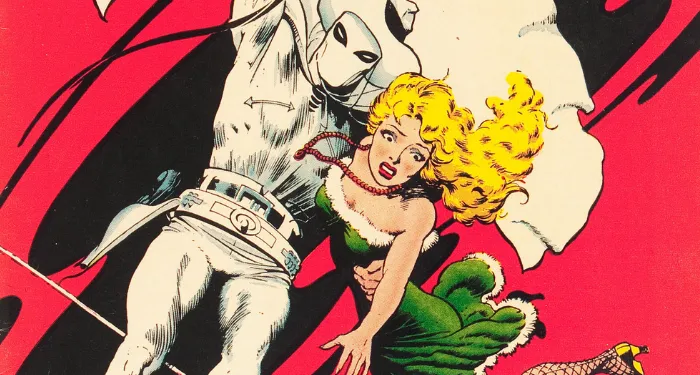
Retro Comic Rewind: Ghost Rider
Some comics go down in history as masterful examples of the craft and are beloved by multiple generations. And others end up at the landfill. In this series, I’ll be looking back on some forgotten series to better understand what kind of comics our ancestral nerds were reading in the days of rotary phones and record players.
Today’s subject: Ghost Rider! But not that one! But also, yes, that one, sort of!
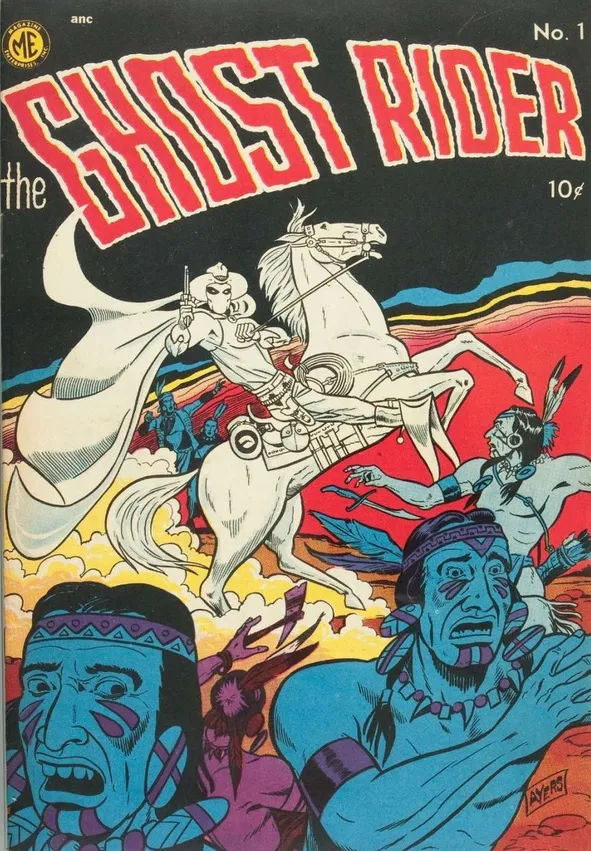
The Context
In the early 1950s, superhero comics were going out of fashion, and just about every other type of comic was about to have its day in the sun. Western and horror comics were among the genres experiencing a surge in popularity, so it made total sense to combine the two.
The Creators
We can thank publisher Magazine Enterprises for this one. Founded in 1943, this was the company that Superman’s creators, Siegel and Schuster, worked for after losing the rights to the Man of Steel and leaving DC. Alas, their work here wasn’t nearly so timeless, but the Ghost Rider has had a much more interesting journey.
Ghost Rider was created by Ray Krank and Dick Ayers, and he first appeared in Tim Holt, a Western comic named for a popular B-movie cowboy actor. He earned his own title — this one we’re talking about today — in 1950, which was published over the next four years.
Ayers is now best known for the inking work he did for Jack Kirby on Fantastic Four in the 1960s, for which he shared in a 1963 Alley Award. But Ayers was an accomplished artist in his own right, as this series proves. We also get art from Frank Frazetta, who contributed several early covers.
The Comic
Right on the first page of the first issue, we get negative stereotypes of Indigenous people and Chinese people. How…efficient?
Anyway, Ghost Rider has had a couple of origin stories, although they are very similar. Originally, in Tim Holt #11, his backstory went like this: in the Old West, U.S. Marshal Rex Fury is grievously injured while thwarting an attack from Native Americans (bizarrely led by a white man disguised as an Indigenous person). The culprits assume he is dead, so Fury takes advantage of their ignorance by coating himself and his horse in a white substance (phosphorescent paint, one assumes, though it’s not clear) to scare his would-be killer.
Ghost Rider #1 revamps this origin somewhat. It begins the same, but rather than simply surviving the murder attempt, Fury is left hanging between life and death. While in this state, he is visited by the ghosts of colonialism past, from Wild Bill Hickock to Calamity Jane, who teach him all he needs to know about shooting, fighting, and tracking. They even gift him a white horse, Spectre. Fury would later add some tricks of his own to make himself seem less human.
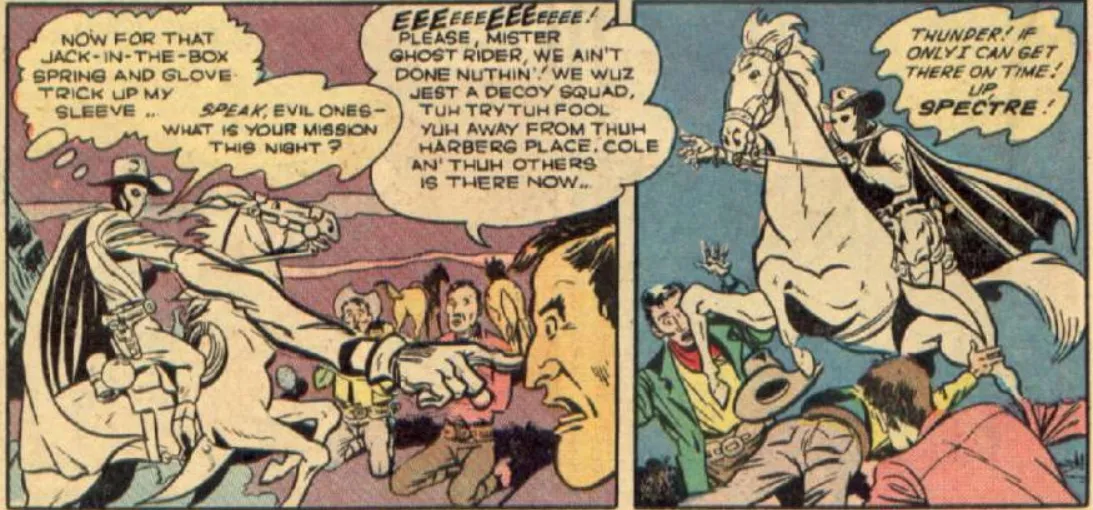
Upon returning to the land of the living, Rex, as the Ghost Rider, uses his newfound skills and his phosphorescent costume to scare criminals into thinking he is an undead spirit of justice, here to avenge the people who have died because of their evil schemes.
I should also mention that Ghost Rider had a Chinese sidekick named…sigh…Sing-Song, who looks upsettingly like Chin-Kee from American Born Chinese. If nothing else, Sing-Song is an intelligent, useful sidekick, often coming up with clever ideas to either save Ghost Rider or defeat the bad guys.
In any case, Sing-Song disappears from the comic after a while, except for a couple of appearances in Issue 13, the second-to-last issue.
Aside from Ghost Rider’s dead tutors, there are no supernatural elements in the early stories. Whenever it seems like a ghost or spirit shows up, it is inevitably some charlatan in a costume. Ghost Rider even expresses skepticism that otherworldly entities could exist at all, even though he personally met several of them.
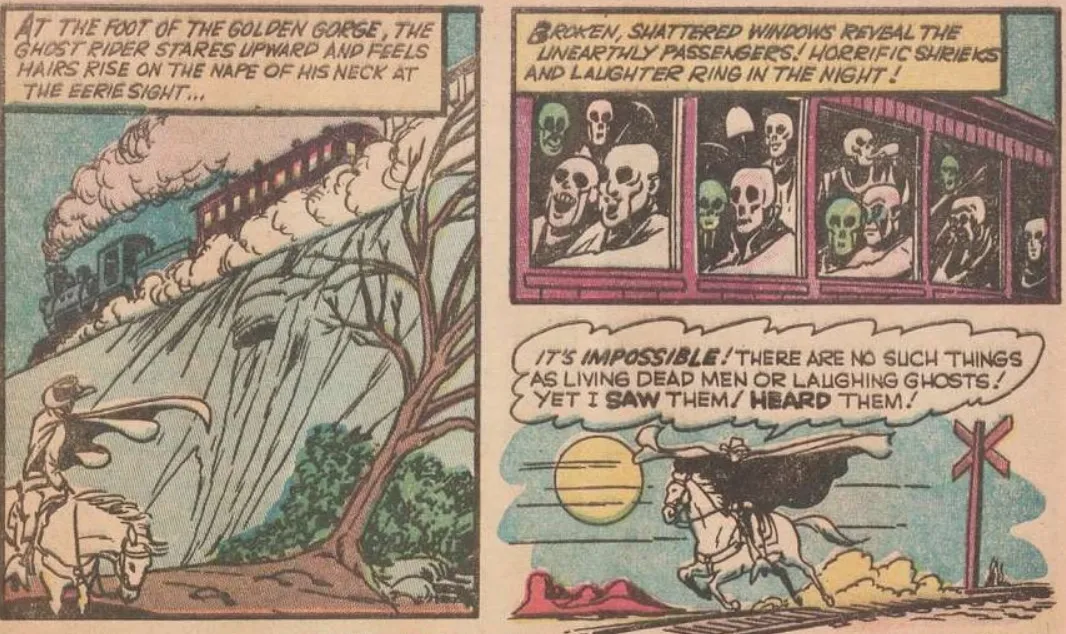
Presumably, someone questioned this because Issue 7 started experimenting with a backup feature, “Tales of the Ghost Rider,” which doesn’t feature Ghost Rider but does include supernatural creatures like werewolves. Ghost Rider himself would only face supernatural entities once: he encounters zombies in Issue 7. It’s a very weird and obvious missed opportunity.
Nevertheless, it’s a pretty fun comic. The plots get a bit redundant after a while — there’s always some greedy human willing to murder and/or execute elaborate hoaxes for profit — but Ayers’s art truly stands out…in most ways. Like too many other artists, he only seems capable of drawing one (1) female face despite the impressive variety he brings to his male characters.
The comic even features a precursor to that other Ghost Rider’s penance stare: in Issue 13, Fury uses mirrored glasses to make his victim think he is seeing flames that reflect his own guilty conscience.
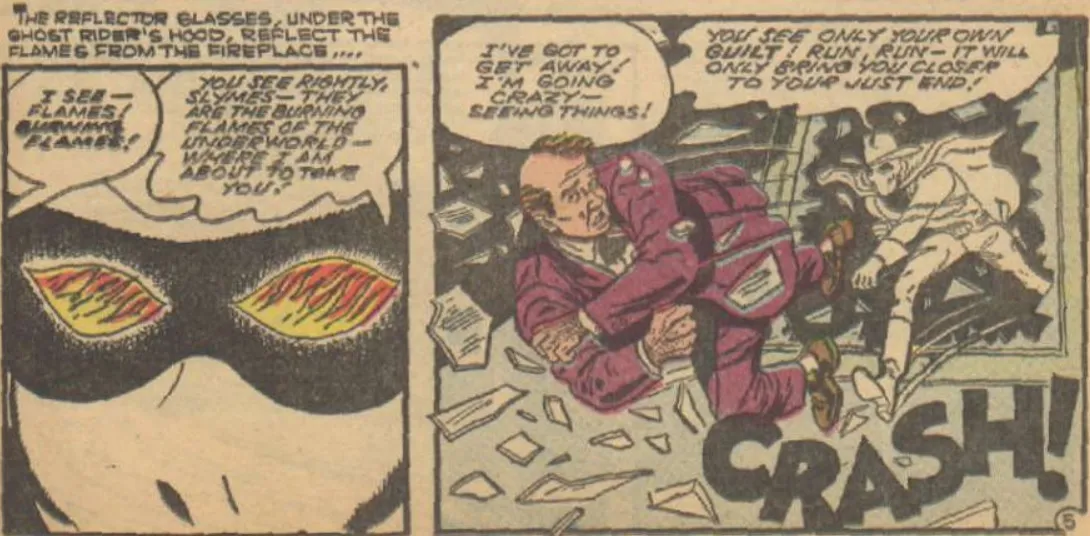
Ghost Rider lasted 14 issues and achieved at least enough popularity to inspire some merchandise (several issues advertise a special scarf that can double as a mask) before being cancelled in 1954.
The Legacy
Once ol’ Ghosty fell into the public domain, Marvel happily yoinked his code name, his costume, and crucial elements of his backstory for their own version of the character, schoolteacher Carter Slade, with Dick Ayers once again supplying the art. But it wasn’t until 1972, when Johnny Blaze showed up with his motorcycle and flaming skull head, that the character’s legacy was cemented.
(For my money, there are also similarities between Rex Fury and Marvel’s Moon Knight, both in terms of appearance and origin story. But that’s probably a coincidence.)
Nowadays, Rex Fury is going by a different name, the Haunted Horseman, to differentiate himself from the more popular, Marvel-owned iterations of the character. Marvel itself seems determined to erase Rex Fury from the history books: the cover of 1967’s Ghost Rider #1 describes the book as “another…first from Mighty Marvel” — as if the character had no history prior to their acquiring him — and as of this writing, their website describes Carter Slade as “the FIRST Ghost Rider,” complete with defensive capital letters. Rude.
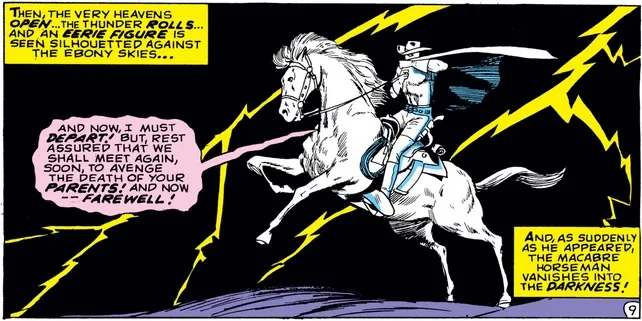
It’s a shame because Fury doesn’t deserve that. If you’re able to grit your teeth through the racism (not to mention the occasional ableism and fatphobia), Ghost Rider is worth a look for fans of fantastic art and/or the Ghost Rider franchise. In any case, it’s interesting to look back on the seeds that would grow into a more familiar character.
Want more vintage goodness? Check out previous editions of RCR: Race for the Moon, Stamps Comics, Tippy Teen, Winnie Winkle, Hangman Comics, G.I. in Battle, Adventures in Wonderland, The Man from U.N.C.L.E. (1993), The Arrow, and Weird Horrors!










